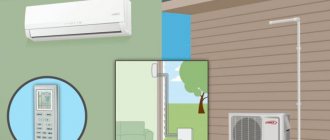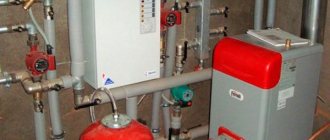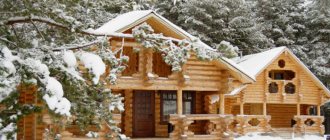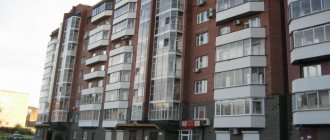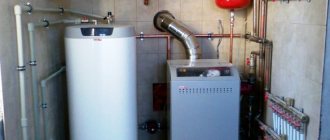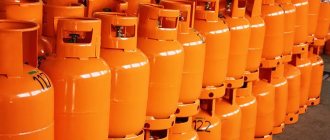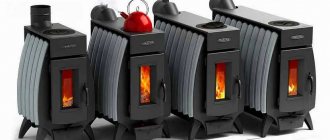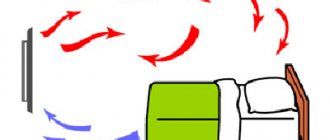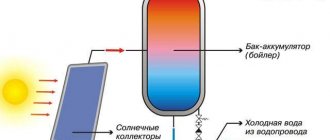Every modern inverter air conditioner can work not only for cooling, but also for heating.
It turns out that this device, in theory, can be used all year round, and not just during the summer heat.
True, there are people who still don’t believe in this, and you can easily find similar comments on the Internet.
By installing a good air conditioner as the main source of heating, you get rid of the problems with setting up and operating a gas or solid fuel boiler.
Radiators and heating pipes disappear from the rooms. There is no need to rack your brains about how best to lay out the system. Which pipes should be used to extend the supply and return lines from the boiler room in order to minimize losses.
How to adjust the temperature in the circuits. And many many others.
With an air conditioner, everything is simple and clear. Choose an installation location, pay 10-15 thousand for installation, or do it yourself, turn it on and use it.
However, do not forget that in fact, in this way you are switching to heating with electricity. All air conditioners are connected from an outlet.
And here a natural question arises: how profitable is such heating? Won't it be unprofitable compared to the same heaters or convectors?
To understand this, let's understand all the technical features and nuances.
Feasibility of the process
Air conditioners with heating function are structurally different from their older counterparts. The devices are equipped with a heat pump, making them very economical: one kilowatt of electricity spent on the air conditioner produces 2.5 to 4.2 kW of heat at the output. The devices are capable of efficiently heating a room at outside temperatures from 0 to -15 degrees, but more powerful units can easily cope with frosts of 30 degrees. For comparison: an oil heater, consuming the same kilowatt of electricity, is capable of delivering only 0.95 kilowatts of heat.
It follows from this that heating costs using an air conditioner are spent two times less than heating a house with a heater. However, it is advisable to choose an air conditioner as a heat source only in non-gasified regions, or in places where expensive liquefied propane is used instead of natural gas. In other cases, heating with air conditioning is certainly more expensive than heating with natural gas, and preference should be given to the latter.
Air conditioning heating in winter: pros and cons
An air conditioner is a special household appliance designed to cool air. Manufacturers of climate control equipment equip modern split systems with a heating function, which allows the owner to operate the air conditioner not only in summer, but also in the cold season, creating a warm, comfortable atmosphere in the room. Thanks to the built-in settings system, the user can set the required air temperature in the room.
The heating option is an undeniable plus of climate systems. But there are also disadvantages.
Features and disadvantages of heating with air conditioning:
- An air conditioner is not a full-fledged heating device, so many manufacturers recommend using them as an additional heat source or for heating rooms in the off-season, when the central heating system is not yet operating. But if you choose an air conditioner with sufficient power for the heated area of the room, such a device will completely replace conventional radiators.
- Split systems cannot be used for heating if the outside temperature is below the critical temperature indicated in the user manual. As a rule, the maximum value of many models is –100, –150. Thus, for many northern regions of Russia, cold winter weather becomes a serious obstacle to the operation of climate control equipment for heating. The only way out is to purchase a special winter kit for connecting to an air conditioner, which allows you to operate the equipment at high sub-zero temperatures.
- In the southern regions, where the air temperature in winter rarely drops below -100, such a device can become a full-fledged source of heat, taking into account the correctly selected power.
- The air conditioner operates from the mains and uses a certain amount of energy during its operation. During the winter season, the device operates at high power and consumes more energy. The owner is advised to calculate in advance how profitable it will be for him to operate the air conditioner for heating, or whether it is cheaper to heat with convectors or other types of heaters in the winter season.
Optimal operating conditions
The air conditioner can be turned on for heating at temperatures above 0 degrees, and preferably above +5 degrees (in winter, spring and autumn) - this is the verdict of experts. It’s best to look at the instructions for a specific device, where the operating range will be indicated. There are models that can operate in an extended range - for example, up to -5 degrees. It is prohibited to use them in frost below this mark.
Some models can be used at fairly low temperatures, but they are rarely found on sale and are more expensive. They work in temperatures as low as -25 degrees, which is important for regions with cold winters.
Air conditioner as a heat pump
Summer this year did not go well in Central Russia in general and in Moscow in particular (just like a year ago). Few people turned on the air conditioner for cooling. But our winters are long, and if the need for air conditioning is not so strong, then without heating - nowhere!
Heating with an inverter air conditioner is approximately 3.5-4.0 times more profitable compared to electric heaters and radiators! The efficiency is higher than heating a house with diesel or any solid fuel. Second only to the cheapest option - main gas! If he exists, of course...
Any split system is a heat pump; there are no heating elements; heat is pumped and extracted from the outside air (even at sharply negative temperatures) due to the supercooling of freon in the external unit. The resulting heat is released by the indoor unit into the room.
This is an air-to-air operating pattern. Installation costs and types of work performed are absolutely similar to the classic installation of a household air conditioner. Let us repeat once again: an air-to-air heat pump is the same household air conditioner with one small difference: it has an extended operating temperature range, allowing the split system to continue operating down to -30oC.
To work in such harsh conditions, manufacturing engineers provide special two-stage compressors and configure the operation of expansion valves in a certain way. All this allows you to maintain high heating efficiency even in severe frosts.
Advantages of an air conditioner over other autonomous heating systems
A widespread type of autonomous system is a boiler that runs on gas or solid fuel (coal, wood). This type of installation replaced the traditional stone oven. Heating with an air conditioner has a number of advantages over a boiler, here they are:
- Lack of pipes and batteries in the room;
- There is no need to punch holes in the walls to install the heating circuit;
- Significant reduction in financial costs for maintaining and maintaining the system in working order.
The air conditioner does not take up much space and this is another advantage. Only one question remains - how much more profitable will heating with electricity be? You can get the answer to this question by considering several factors.
Advantages and disadvantages of a split system for heating
Whether or not to heat using an air conditioner is a matter for each user to decide for himself privately. But if the decision turns out to be positive, then you can be sure that the air will not dry out, as when using heating devices. There are other advantages:
- environmentally friendly use (no CO2 emissions);
- Three times more heat will be produced than electricity consumed.
But in addition to improving the microclimate, there are also pitfalls. You should definitely be aware of them if you use them regularly.
- The device will wear out 3-5 times faster. This will happen due to thickened oil, which will lose its properties.
- There is a trend towards replacing the refrigerant - R410, which is safer for the ozone layer, will be used. This requires the installation of more advanced compressors.
- The performance of the device will become half the nominal.
- Air conditioning for heating often breaks down in winter.
Energy efficiency at home
Russian YouTube is full of videos about air-source heat pumps on air conditioners, and for some reason there is a clear tendency everywhere that if someone scolds them, they will definitely miss the advantages of the device and inflate the disadvantages, and vice versa.
This article will touch on both the positive and negative aspects of the issue.
Before you consider heating with air conditioning, check the insulation and energy efficiency of your home.
If it is useless, then no matter how powerful the unit you install, you will not stay warm in winter. And the type of heating has nothing to do with it.
It’s not for nothing that they say that the best heating is insulation! When everything is in order with this, you can start choosing an air conditioner.
Why is frost dangerous for an air conditioner?
The operating principle of an air conditioner is quite simple, but changing conditions at any stage can lead to serious damage.
Firstly, starting a cold compressor is dangerous. The oil in it thickens at low temperatures, and therefore the unit operates under increased load.
In addition, without lubrication, the friction of metal parts produces chips that clog and damage the system. Therefore, even a new compressor installed to replace a broken one can quickly fail even with correct operation.
Secondly, the freon in the external radiator may not have time to evaporate. The activity of heat exchange depends on the temperature difference. Therefore, with a slight plus outside, freon, warming up from -400C, will absorb a lot of thermal energy.
If it is -300C outside, then the refrigerant may not have time to warm up even to the boiling point. The result is liquid freon entering the compressor and its inevitable breakdown due to water hammer.
The third danger is condensate freezing and icing.
Remember, when working for heating, the split system blocks change roles, so condensation forms on the radiator that is outside
An ice shell on the outdoor unit interferes with heat transfer and can interfere with the fan, which increases the load on all parts of the system. Automatic defrosting is designed to solve this problem, but the water draining from a heated radiator often immediately freezes in the pan. When the ice layer reaches a certain thickness, the fan blades freeze into it, and the air conditioner stops working.
Condensation in the drain pipe can also freeze at the point of exit to the street - if the air conditioner is working on cooling. This may be necessary in winter in server rooms or in the defrosting mode mentioned above. Such an ice plug prevents further drainage of condensate, and it begins to ooze down the wall, provokes the development of mold in the indoor unit, and can damage it.
Even cooling work in winter can cause problems. In this case, the air conditioner takes too much cold from the street, and the condensation on the indoor unit turns into frost and ice. Naturally, this is also detrimental to the equipment. In addition, the problem of cold start of the compressor remains relevant.
The principle of operation of an air conditioner for heating
When you turn on the air conditioner in heating mode, the refrigerant changes from a liquid state to a gaseous state and evaporates, partially taking away the heat. The compressor transfers the gas refrigerant to the internal block of the split system, and all the heat accumulated along the way is released in the evaporator. Warm air enters the room, raising the temperature.
Efficiency and heating efficiency of air conditioning
Efficiency is the efficiency factor expressed as a percentage.
In the split system passport you can see the efficiency, EER and COP indicators, where EER determines the cooling efficiency, and COP is the average indicator of cooling and heating efficiency. As a rule, EER is always less than COP, since during operation the compressor generates heat and warms the freon. Using these parameters, you can determine the efficiency of heating.
For example, the product data sheet contains the following data: COP – 2.6; EER – 2.4; Efficiency – 260%. These parameters indicate that when consuming 1 kW of energy, the air conditioner will produce 2.4 kW of cold and 2.6 kW of heat. However, these values also depend on the difference in temperature between indoors and outdoors. The greater the difference, the lower these indicators, so the colder it is outside, the worse the efficiency of the air conditioner for heating.
How to increase the efficiency of an air conditioner for heating:
- Make sure there is no ice on the outdoor unit.
- Connect a special winter kit to the split system.
- Carry out preventive cleaning of the units from dust and other contaminants that impair the operation of the device.
- If the weather outside is too cold, use other heat sources for heating.
- When installing the outdoor unit of a split system, try to choose a place protected from wind and moisture.
Thermal insulation and energy efficiency of the room
Obviously, the highest efficiency is achieved in those rooms that have sufficient thermal insulation. Insulated walls, floors, double doors, tightly closing windows - all these measures will increase the energy efficiency of the house.
A room with drafts and without at least basic insulation will always be cold, both in winter and autumn. In such a situation, a heating installation of any model will be powerless, regardless of its power. Before switching to an autonomous heating system, it is necessary to carefully insulate the building itself.
The difference between the operation of an inverter air conditioner
What is an inverter air conditioner and how does it differ from a simple one? The traditional device works according to a simple scheme: it heats the air to a certain temperature and immediately turns off the compressor. The so-called ON-OFF system.
That is, the compressor either works or doesn’t work at certain periods of time. But in inverter models it is possible not to completely turn off the compressor, but to reduce its rated power.
Why does this happen? Due to double conversion of electric current.
Initially, the standard alternating voltage from a 220V outlet is converted to direct voltage. And only then, with the help of an inverter, the direct current is again converted into alternating current, but not with the usual frequency of 50 Hz, but with an arbitrary one.
By adjusting and changing this very frequency, you can regulate the speed of the compressor rotor, and therefore change the power during operation.
You may ask, why all these troubles with frequency and power, and what exactly do they give? And they provide several advantages:
- absence of large starting currents when turned on
- less equipment wear
- but most importantly, a lower permissible operating temperature
That is, inverter models are able to start and operate at outside temperatures of -15C and below (-25C and even -30C). The oil in the system does not stagnate, but circulates constantly.
Most inexpensive household inverters certainly do not reach such low temperatures and operate normally between -5C and -7C.
If you installed such a household model at home, and the frost outside hit -25C, is it possible to turn it on or not? There are several options here.
Firstly, it may simply not start and go into defense. But if it does start working, its efficiency will drop significantly, as will the temperature in your house.
If such a low temperature remains for several days in a row, the oil in the device will thicken.
In this case, it is not recommended to turn off the air conditioner, otherwise a subsequent cold start will kill its compressor.
During operation, for better heating of the room, all inverter models must be able to direct the air flow vertically downwards. In this case, the room will warm up much faster. There is no particular point in heating the ceiling with warm air.
Because of this feature, some advise placing the indoor unit as low as possible, at a level of 0.5 m from the floor. True, in summer such cold for the feet will be very unpleasant.
COP and air conditioner efficiency
However, the ability to operate at low negative temperatures is not the main thing. What else should you focus on when choosing an inverter air conditioner, so that its operation creates a sufficient amount of heat in the house and is profitable at the same time?
The COP (Coefficient of Performance) coefficient is responsible for this - the coefficient of efficiency or conversion. It can be found in the full list of characteristics.
COP is the ratio of the thermal performance of an air conditioner in heating mode to its electrical power, that is, how much electricity it consumes from the outlet.
What COP value is considered good? For the best models it reaches 5 units. From 3.5 to 4.0 these are average parameters.
For example, cop=3.61 means that with a power of 1 kW, such an inverter is capable of pumping a thermal power of 3.61 kW into the room in 1 hour.
A similar parameter when working for cooling is called coefficient. EER. It shows how much thermal power is pumped out of the room in accordance with the consumed electrical power of the air conditioner.
The higher the COP, the more profitable and expensive the air conditioner. As mentioned above, a good value is COP=5.0. Having such a device, having spent one kilowatt of electric energy in 1 hour, you will drive 5 kW of heat into your room.
How profitable is this? At current prices for electricity, 1 kW of heat when heating with such an air conditioner in Moscow or the region will cost you about 1 ruble.
In some regions, costs will be one and a half times less. It seems that it is even cheaper than heating with wood, not to mention heating with other electrical appliances.
But this is where the main trick lies. The OPC parameter specified in the technical documentation was measured under some ideal conditions. Specifically, when working for heating with an ambient temperature of +7C.
As the outside temperature decreases, the COP will decrease, just as it does when the room temperature increases. If the best Japanese inverters have a COP of 5.0 at outdoor temperature t=+7C and room temperature +20C, and you want to heat up the room to +30C without changing the outdoor parameters, COP will immediately drop to 4.0-4.5.
And if it gets colder outside, this parameter will drop much more. In frosts of -25C, branded “Japs” have a COP within the range of 1.5-2.0. That is, the efficiency drops by half.
So what, you say. It’s still more profitable and 2 times cheaper than heating with oil batteries or a convector. Actually not quite like that.
When is air conditioning beneficial?
As mentioned above, manufacturers indicate “cop” under ideal conditions. They are “modestly” silent about the energy consumption for defrosting or defrosting cycles, the number and duration of which increases at -15C and below.
Add here the extra kilowatts for heating the sump and compressor crankcase. What's left in the end?
And as a result, at temperatures from -15C, even with a relatively modern inverter, you will save energy in the region of 10-20% compared to conventional heaters.
If the COP was initially low (domestic model), then you will not receive any benefit at all. It's the same as buying a 2-kilowatt heat blower and running it under the ceiling.
Therefore, look at the average annual winter temperature in your region and in the presence of prolonged cold weather, buy air conditioners with a COP efficiency rating of 4 or higher.
Only in this case will heating with air conditioners be more profitable than heating the room with direct heating devices.
To understand the effectiveness of a particular model, you need to compare their COP graphs depending on the ambient temperature.
Comparison of air conditioners when operating for heating
Below are independent results of research and measurements of this coefficient (taking into account defrosting cycles!), which were carried out with some of the highest quality brands of air source heat pumps - Mitsubishi Electric, Panasonic, Gree, Fujitsu.
Panasonic CS-NE9MKE + CU-NE9MKE
Panasonic CS-HE9LKE + CU-HE9LKE
Gree Hansol 25-A (GWH09TB-S3DNA2D/I) + GWHT09TB-S3DNA1D/O
Mitsubishi Heavy Industries SRK25ZJX + SRK25ZJX-SA
Fujitsu ASYG09LMCB + AOYG09LMCBN
The market leader is Mitsubishi Zubadan. However, you should not believe the marketing and purchase budget models of this brand. They are distinguished from conventional splits mainly by a more powerful compressor. You are unlikely to get normal heating at -25C from them either.
The energy efficiency of real Zubadans, depending on the region of your residence and the average temperature in winter, can be calculated on a convenient online calculator on the Mitsubishi website here.
Based on the above tables, you can make your choice. Complete data on the most popular and effective brands with test reports are available via the link here (site in Finnish, use Google translator).
If COP is not initially indicated anywhere on the device, you can calculate it yourself. To do this, divide the thermal power, which is written on the device nameplate, by the consumed electrical power.
Features of operation in winter
In winter, the air conditioner defrosts at certain intervals. This usually happens once every 40-60 minutes.
When working for a long time at subzero temperatures, its radiator freezes over, efficiency drops, and the system begins to deal with it on its own.
Many people mistakenly believe that the external unit in this case is heated by some kind of built-in heating elements. This is wrong.
It simply switches the direction of its work. That is, hot freon from the indoor unit begins to flow into the outdoor unit. And it thaws within a few minutes.
The duration and frequency of defrost cycles depends on the degree of icing and is controlled by sensors. Although in inexpensive options this happens simply according to the programmed time.
Air conditioner operation in heating mode in winter
Now let’s move on to the main thing and find out whether it is possible to run a split system to heat a room when there is a significant “minus” outside.
At what external temperatures is heating mode possible?
Most modern air conditioners can operate for heating only if the temperature outside the window is not lower than -7°C...-15°C. More accurate information on the lower temperature threshold can be found in the instructions for the device. If you use the device at lower thermometer readings, the heating power will be less. In addition, there will be a threat of icing of the drainage system and condenser, which inevitably leads to breakdown of the entire split system.
In the photo: The operating principle of modern split systems
But depending on the refrigerant and the type of compressor, some air conditioners can operate in heating mode at lower temperatures, for example -15°C...-30°C. We are talking about advanced models of inverter split systems.
For what reasons does the air conditioner not work for heating?
If the device has the ability to operate to heat the room, but it does not switch to this mode, the compressor, drainage system, or valve that switches the refrigeration circuit to heating may have broken down. There is also a possibility of refrigerant leakage at the joints of the tubes. In this case, it is worth calling an air conditioning equipment repair specialist.
Another popular reason is that the temperature outside the window is below the permissible minimum, so the air conditioner can only slightly increase the heat level in the room.
If the device works normally, but the air in the room does not heat up, then perhaps you should just wait a little - sometimes the system needs additional time for the indoor unit to warm up. This is quite normal in winter.
The display of the indoor unit, which displays error codes in the operation of the split system, can also help you understand the causes of the malfunction.
If you cannot install and fix the problem yourself, it is better to contact a specialized service center.
Mobile air conditioner without hoses
There are mobile floor air conditioners without hoses. Their system does not use refrigerant; they work by forced evaporation of water. The operating principle of such a mobile air conditioner is as follows:
- Air is drawn from the room by a fan;
- It passes through a filter that traps dust and dirt;
- A stream of air is blown through a membrane moistened with water;
- Moisture particles evaporate from the membrane, its temperature drops and cools the air;
- Humidified and cooled air enters the room.
The principle of operation of a mobile air conditioner without hoses and air ducts.
There are large, fully functional models. Their cost is lower than that of conventional mobile air conditioners that use freon to produce cold. But the efficiency is much lower.
Depending on the power of the evaporative air conditioner and the volume of the room, it can reduce the temperature by 1-5 degrees in 1 hour. It does a good job of maintaining the temperature in a chilled room.
The disadvantage of such air conditioners is constant air humidification. Due to low efficiency, they must be constantly running. Due to this, humidity increases. This can negatively affect your well-being; drops of water condense on furniture and household items.
In recent years, mini air conditioners such as Arctic Air have appeared. Manufacturers and sellers talk about their effectiveness, but in practice it is a hoax. With small sizes and low power, they can cool a room of no more than 2 sq.m. area. Read more about their “efficiency” in the article: Arctic Air mini air conditioner: reviews, deception of sellers and principle of operation.
There are high power models that are used for centralized cooling. They also serve as a ventilation system. This evaporative air conditioner takes air from outside the home, cools it, and delivers it inside.
Preparing the air conditioner for winter
In order to prepare the device for the winter season, a number of preventive measures need to be taken.
It is necessary to dry the indoor unit from accumulated condensate. To do this, the air conditioner must first be turned on for cooling for a while, and then turned on for heating for the same period. Clean the built-in filters from accumulated sawdust and dirt. If conditions permit, install a protective canopy on the external unit.
If there is a standard household air conditioner in the room, then it is better to limit it to turning it on in heating mode only during the off-season - until the temperature drops below the limit values set by the manufacturer.
Criterias of choice
The quality of heating the room will depend on the correct choice of air conditioner, which directly affects the comfort of the home. Before purchasing a system, its functional responsibilities should be clearly defined. If you plan to install hot water supply, you must opt for inverter units equipped with an additional hydraulic module. External air temperatures in winter have a decisive influence on the choice of air conditioner. And if in the southern regions of the country you can limit yourself to purchasing a traditional model, then in conditions of a sharply continental climate with night temperatures dropping to -30 degrees, you should buy a serious device equipped with a heat pump and a system for protecting against freezing of oil and condensate.
When choosing a device with a hydraulic unit, you should remember that if the device is installed outside, then it will have to be insulated for the winter. This especially applies to country houses in which accommodation during the winter period is carried out periodically or completely absent. When the hydraulic unit is located internally, the device can be connected to the “warm floor” system and radiators. Installing such equipment will certainly cost certain costs, but they will quickly pay for themselves during the life of the device.
How to choose the right model
How the heated air conditioner works will depend on the correct selection of the model.
Here it is important to pay attention to the characteristics of COP (heating to consumed power ratio) and EER (cooling/consumption ratio):
- COP in home models should be 2.8-4;
- for EER this figure can be 2.5-3.5 units.
Regardless of the recommendations, this type of equipment will need to be installed individually, taking into account the characteristics of the room. In this case, it will be important to calculate the possible heat losses that come from windows and doors. It is in these places that it would be reasonable to create a thermal curtain. A little about control: the equipment will be switched either from the remote control or manually. Heating can be set automatically.
How much will you have to pay?
The heating split system itself costs from 50,000 rubles. plus installation. Although this work in private homes can be done independently. However, this is only the case when you have not only the right tool, but also the knowledge. It may seem that heating a room with a heat pump costs the same as using a breeze or any other household heater. But actually it is not. Home heaters use energy to heat the coil and operate the fan. A split system, on the other hand, takes heat from the air and spends energy only on the fan and heating the working elements to prevent ice. As a result, according to manufacturers, the efficiency of heat pumps is approximately 3-5 kW of heat per 1 kW of expended electricity, while for a conventional heater 1 kW of expended energy is equal to 1 kW of heat. These calculations are, of course, very arbitrary. Much depends on the heater model, the energy efficiency of the room, weather conditions, etc. But nevertheless, a conclusion can be drawn. You can install the air conditioner yourself. The main thing is to follow the manufacturers' instructions. As a result, if you do not have the opportunity to heat your house using a gas boiler or you do not want to constantly be dependent on the supply of fuel to solid fuel boilers, of all the remaining heating options using electricity, using a heat pump may be the most cost-effective .
Things to consider
Climate control equipment has several useful options:
- Cooling mode.
- Heating.
- Ventilation.
- Drying.
- Ionization.
Manufacturers add other functions to various models.
Many models of split systems support an automatic mode, which independently selects the desired operating option, focusing on microclimate parameters: temperature (internal and external), humidity, etc. If this is not provided, you need to take into account some nuances before switching modes yourself.
Winter air conditioner kit
Recently, more and more often you can find proposals for equipping an air conditioner with a winter kit. Sellers of this equipment assure that its installation will make the air conditioner an effective heater throughout the winter, even in frosty weather. Whether this is so - we will figure it out.
Components of a winter work kit
A low-temperature kit, as a rule, includes 3 components: a heating pan, a compressor crankcase and a fan speed controller. Sometimes there is also a temperature sensor and a control board - separate for each component or common to all.
Heating the pan is necessary to prevent the condensate draining from the radiator from freezing when the defrost mode is turned on.
The crankcase heater is a wire or plate that surrounds the compressor in the place where oil accumulates.
It is advisable to turn on the compressor heating before starting the air conditioner so that the oil has time to warm up. In practice, heating often occurs either only during operation or only during idle time. Only the second option will ensure safety for the compressor, but it is less profitable due to increased energy consumption.
Thanks to crankcase heating, you can avoid cold starts and operation of the compressor when the lubricant has thickened in the cold, which means increased load during startup and wear of moving parts
Adjusting the fan speed determines the activity of heat exchange between freon and the external environment: the stronger the air flow, the more heat is transferred. When working for heating, this is not critically important, because maximum heat transfer is needed, and high fan speed is set from the factory.
It’s another matter if the air conditioner operates for cooling at temperatures below +14 – +180 allowed by the manufacturer. Then the freon can give off too much heat, and the indoor unit will begin to freeze: it will become covered with frost and ice, and the condensate will freeze. To prevent this from happening, the fan is slowed down.
Is it advisable to install a winter kit?
After installing a low-temperature kit, the owner may have a question: is it now possible to heat the room with an air conditioner at low outside temperatures? The answer is yes, you can, it is now safe for the air conditioner. The exception is unqualified installation or home-made equipment.
If there is dripping from the roof on the air conditioner and therefore huge icicles form, a winter kit will not help - you need a protective visor
Is it effective? Air conditioning heating is valued for its efficiency: its efficiency can reach 3 – 5 and even 7, depending on the model. This is achieved by the fact that the split system is the only heater that does not produce heat. The compressor and fans require much less energy to operate than the system can move into the home.
The declared efficiency, or, as the manufacturers write, COP, is relevant when operating for heating at +70 outside. As it gets colder, the temperature difference between air and freon decreases, which means heat exchange worsens and the efficiency of the air conditioner decreases.
At temperatures below -150C, the efficiency of the air conditioner decreases to approximately 1%, that is, for every kilowatt of electricity consumed, only 1 kW of heat can be obtained. Conventional convectors or infrared heaters, which are cheaper and do not depend on the outside temperature, also have such indicators.
Of course, these calculations are approximate; the result greatly depends on the model of the air conditioner, the low-temperature set, and even the connection diagram of the second one. But the fact is that the lower the temperature outside, the less effective and economical heating with a split system is.
Considering that the cost of a good winter kit for turning on heating with an air conditioner with installation can be 40 - 150% of the cost of the air conditioner, and it will work effectively only down to -150C, the feasibility of the purchase is very controversial.
When the air conditioner operates for cooling in winter without a low-temperature set, frost and an ice crust forms on the indoor unit
It's another matter if you need to cool the room in winter. For example, for a room with equipment. Then the lower limit of permissible temperatures drops from +16 declared by the manufacturer to severe frosts, and the efficiency of the air conditioner will not decrease.
What kind of air conditioners can be used for heating?
When buying a split system, you should look for the word “reversible” in the description: it indicates the ability of the device to change the direction of freon flow and work for heating.
The heating function is present in most modern systems; only the temperature at which it is allowed to be used differs. Indicated by the sun symbol or the word Heat
After the problems described, you may get the impression that the heating function in air conditioners is useless and dangerous for the device, but this is not the case. Although the split system will not save you in severe frosts, it will help create a comfortable microclimate in the off-season, when the central heating is turned off and it’s cold outside, or in a temperate climate.
The lower temperature limit at which the split system can be turned on for heating depends on the model - it is indicated in the instructions.
There are certain patterns in the distribution of these temperatures:
- Air conditioners with a linear control type can usually only be turned on down to -50C, since the compressor is constantly turned off and has time to cool down before restarting.
- Inverter models usually operate down to -150C, but some specialized devices are effective down to -20 and even -300C.
- It is sometimes possible to expand the range of operating temperatures declared by the manufacturer by installing a winter kit - we’ll talk about this in more detail later.
- Monoblock air conditioners with a heating function do not depend on the outside temperature, but they are no different in terms of efficiency. In winter they work like a regular convector, with an efficiency of slightly less than 1.
- Systems with R22 refrigerant are less efficient and resistant to low temperatures than those filled with R410A or R32 freon.
It is worth noting that even those models that operate smoothly at low temperatures significantly reduce the efficiency and economy of heating when it gets cold outside.
You cannot simply replace the R22 freon in the air conditioner with a more efficient and modern one - its operating pressure is half as low, and the system parts are not designed for more
Given operating temperature limitations and inconsistent performance, air conditioning cannot be the primary heating appliance for homes in northern regions.
